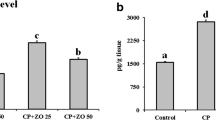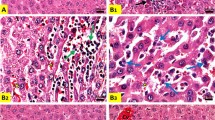Abstract
Cisplatin (cis-diamminedichloroplatinum (II) (CDDP)) is a commonly used chemotherapeutic drug for the treatment of numerous forms of cancer, but it has marked adverse effects, namely nephrotoxicity, hepatotoxicity, ototoxicity, neurotoxicity, diarrhoea etc. CDDP-induced emesis and diarrhoea are also noticeable toxicities that may be due to intestinal injury. Zingerone; a phenolic alkanone, one of the active components of ginger, possesses multiple biological activities, such as antioxidant and anti-inflammatory properties. In the present study, we investigated the protective effect of zingerone against CDDP-induced jejunal toxicity. Animals were divided into five groups I-IV (n = 6). Group II, III and IV received single intraperitoneal administration of CDDP at 7.5 mg/kg body weight on day 14. Animals of group II and III received oral treatment of zingerone at doses of 25 and 50 mg/kg body weight respectively for 14 consecutive days. While groups I was given distilled water 5 ml/kg body weight for 14 days. All the animals were killed after 24 h of CDDP injection. Zingerone ameliorated CDDP-induced lipid peroxidation, increase in xanthine oxidase activity, glutathione depletion, decrease in antioxidant and phase-II detoxifying enzyme activities. Zingerone attenuated CDDP-induced nuclear factor (NF-κB) activation, enhanced levels of TNF-α and Nitrite. The results showed that zingerone had not only the antioxidant effect by suppression of ROS, but also anti-inflammatory effects by suppression of NF-κB activation. In addition, zingerone treatment suppressed gene activation of pro-inflammatory cytokine, TNF-α, which was up-regulated with CDDP administration through NF-κB activation. These experiments strongly indicate that zingerone treatment exercises a protective efficacy by suppressing both oxidative stress and inflammation through the modulation of key pro-inflammatory cytokine and transcription factors.



Similar content being viewed by others
References
Adenis A, Carlier D et al (2005) Cytarabine and cisplatin as salvage therapy in patients with metastatic colorectal cancer who failed 5-fluorouracil + folinic acid regimen. French Northern Oncology Group. Am J Clin Oncol 18:158–160
Ali BH, Blunden G et al (2007) Some phytochemical, pharmacological and toxicological properties of ginger Zingiber officinalis Roscoe: a review of recent research. Food Chem Toxicol 46:409–20
Basu A, Krishnamurthy S (2010) Cellular responses to cisplatin-induced 501 DNA damage. J Nucleic Acids 1–16. http://dx.doi.org/10.4061/2010/201367
Carlberg I, Mannervik B (1975) Glutathione level in rat brain. J Biol Chem 250:4480–4575
Chung SW, Kim MK et al (2009) Peroxisome proliferator-activated receptor activation by a short term feeding of zingerone in aged rats. J Med Food 12:345–350
Claiborne A (1985) Catalase activity. In: Greenwald RA (ed) CRC handbook of methods in oxygen radical research. CRC Press, Boca Raton, pp 283–284
Eastman A (1985) Activation of programmed cell death by anticancer agents: cisplatin as a model system. Cancer Cells 2:275–280
Eljack ND, Ma HY, Drucker J, Shen C, Hambley TW, New EJ, Friedrich T, Clarke RJ (2014) Mechanisms of cell uptake and toxicity of the anticancer drug cisplatin. Metallomics 6(11):2126–2133
Federico A, Morgillo F et al (2007) Chronic inflammation and oxidative stress in human carcinogenesis. Int J Cancer 121:2381–2386
Forman HJ, Zhang H et al (2009) Glutathione: overview of its protective roles, measurement, and biosynthesis. Mol Asp Med 30:1–12
Francescato HDC, Costa RS et al (2007) Parthenolide reduces cisplatin-induced renal damage. Toxicology 230:64–75
Green LC, Wagner DA et al (1982) Analysis of nitrate, nitrite, and [15N] nitrate in biological fluids. Anal Biochem 126:131–138
Grzannar R, Lindmark L et al (2005) Gingere, an herbal medicinal product with broad anti-inflammatory actions. J Med Food 8:125–32
Guerrero-Beltrán CE, Calderón-Oliver M et al (2010) Sulforaphane protects against cisplatin-induced nephrotoxicity. Toxicol Lett 192:278–285
Habig WH, Pabst MJ et al (1974) Gluta thione-S-transferases: the first enzymatic step in mercapturic acid formation. J Biol Chem 249:7130–7139
Heunks LM, Dekhuijzen PN (2000) Respiratory muscle function and free radicals: from cell to COPD. Thorax 55:704–716
Iwami M, Shiina T et al (2011) Inhibitory effects of zingerone, a pungent component of Zingiber officinale Roscoe, on colonic motility in rats. J Nat Med 65:89–94
Jollow DJ, Mitchell JR et al (1974) Bromobenzene-induced liver necrosis. Protective role of glutathione and evidence for 3,4-bromobenzene oxide as the hepatotoxic metabolite. Pharmacology 11:151–169
Kadnur SV, Goyal RK (2005) Beneficial effects of Zingiber officinale Roscoe on fructose induced hyperlipidemia and hyperinsulinemia in rats. Indian J Exp Biol 43:1161–64
Kawanishi S, Yamamoto K (1991) Mechanism of site-specific DNA damage induced by methylhydrazines in the presence of copper (II) or manganese (III). Biochemistry 30:3069–3075
Khan R, Khan AQ et al (2012) Chrysin protects against cisplatin-induced colon toxicity via amelioration of oxidative stress and apoptosis: Probable role of p38MAPK and p53. Toxicol Appl Pharmacol 258(3):315–329
Kim JK, Kim Y et al (2007) Gingerol prevents UVB induced ROS production and COX-2 expression in vitro and in vivo. Free Radic Res 41:603–614
Koc A, Duru M et al (2005) Protective agent, erdosteine, against cisplatininduced hepatic oxidant injury in rats. Mol Cell Biochem 278:79–84
Koo KLK, Ammit AJ et al (2011) [6]-Gingerols and related analogues inhibit arachidonic acid-induced human platelet serotonin release and aggregation. Thromb Res 03:387–397
Koppenol WH, Moreno JJ et al (1992) Peroxynitrite, a cloaked oxidant formed by nitric oxide and superoxide. Chem Res Toxicol 5:834–842
Kumar L, Chhibber S, Harjai K (2014) Hepatoprotective effect of zingerone (4-(4-hydroxy-3-methoxyphenyl) butan-2-One) in lipopolysaccharide induced liver injury mouse model through down regulation of inflammatory mediators. Int J Pharmacogn Phytochem Res 6:308–314
Langner E, Greifenberg S et al (1998) Ginger: history and use. Adv Ther 15:25–44
Laskin DL (2009) Macrophages and inflammatory mediators in chemical toxicity: a battle of forces. Chem Res Toxicol 22:1376–1385
Longo V, Gervasi PG et al (2011) Cisplatin induced toxicity in rat tissues: the protective effect of Lisosan G. Food Chem Toxicol 49:233–237
Lowry OH, Rosebrough NJ et al (1951) Protein measurement with the Folin phenol reagent. J Biol Chem 193:265–275
Manar MH, Brown MR et al (2004) Association of glutathione- S-transferase-P1 (GST-P1) polymorphisms with bronchopulmonary dysplasia. J Perinatol 24:30–35
Marklund S, Marklund G (1974) Involvement of the superoxide anion radical in the autoxidation of pyrogallol and a convenient assay for superoxide dismutase. Eur J Biochem 47:469–474
Miller RP, Tadagavadi RK, Ramesh G, Reeves WB (2010) Mechanisms of cisplatin nephrotoxicity.Toxins (Basel) 2:2490–2518
Mohandas M, Marshall JJ et al (1984) Differential distribution of glutathione and glutathione-related enzymes in rabbit kidney: possible implications in analgesic nephropathy. Biochem Pharmacol 33:1801–1807
Nanji AA, Jokelainen K et al (2003) Curcumin prevents alcohol-induced liver disease in rats by inhibiting the expression of NF-kappa B-dependent genes. Am J Physiol Gastrointest Liver Physiol 284:321–327
Nicoll R, Henein MY (2009) Ginger (Zingiber officinale Roscoe): a hot remedy for cardiovascular disease? Int J Cardiol 131:408–9
Pala FS, Gurkan H (2008) The role of free radicals in ethiopathogenesis of diseases. Adv Mol Biol 1:1–9
Park KK, Chun KS et al (1998) Inhibitory eVects of [6]-gingerol, a major pungent principle of ginger, on phorbol ester-induced inXammation, epidermal ornithine decarboxylase activity and skin tumor promotion in ICR mice. Cancer Lett 129:139–144
Ramesh G, Reeves WB (2002) TNF-alpha mediates chemokine and cytokine expression and renal injury in cisplatin nephrotoxicity. J Clin Invest 110:835–842
Rao BN, Rao BS (2010) Antagonistic effects of Zingerone, a phenolic alkanone against radiation-induced cytotoxicity, genotoxicity, apoptosis and oxidative stress in Chinese hamster lung fibroblast cells growing in vitro. Mutagenesis 25:577–87
Rao BN, Rao BS et al (2009) Radiomodifying and anticlastogenic effect of zingerone on Swiss albino mice exposed to whole body gamma radiation. Mutat Res 677:33–41
Rehman MU, Tahir M et al (2013) Chrysin suppresses renal carcinogenesis via amelioration of hyperproliferation, oxidative stress and inflammation: plausible role of NF-κB. Toxicol Lett 216(2–3):146–58
Rehman MU, Tahir M et al (2014) D-limonene suppresses doxorubicin-induced oxidative stress and inflammation via repression of COX-2, iNOS, and NFκB in kidneys of Wistar rats. Exp Biol Med 239(4):465–76
Saad SY, Najjar TA et al (2004) Role of nonselective adenosine receptor blockade and phosphodiesterase inhibition in cisplatin-induced nephrogonadal toxicity in rats. Clin Exp Pharmacol Physiol 31:862–867
Sherman SE, Gibson D et al (1985) X-ray structure of the major adduct of the anticancer drug cisplatin with DNA: cis-[Pt (NH3)2 {d (pGpG)}]. Science 230:412–417
Shukla Y, Singh M (2007) Cancer preventive properties of ginger: a brief review. Food Chem Toxicol 45:683–690
Stoilova I, Krastanov A et al (2007) Antioxidant activity of a ginger extract. Food Chem 102:764e70
Stripe F, Della Corte E (1969) The regulation of rat liver xanthine oxidase. J Biol Chem 244:3855–3863
Sun Y (1990) Free radicals, antioxidant enzymes and carcinogenesis. Free Radic Biol Med 8:583–599
Surh YJ, Chun K et al (2001) Molecular mechanisms underlying chemopreventive activities of anti-inflammatory phytochemicals: down-regulation of COX-2 and iNOS through suppression of NF-kappa B activation. Mutat Res 1:480–481
Vijayalakshmi B, Sesikeran B et al (2006) Chronic low vitamin intake potentiates cisplatin-induced intestinal epithelial cell apoptosis in WNIN rats. World J Gastroenterol 12:1078–1085
Wang G, Reed E et al (2004) Molecular basis of cellular response to cisplatin chemotherapy in non-small cell lung cancer. Oncol Rep 2:955–965
Wright JR, Colby HD et al (1981) Cytosolic factors which affect microsomal lipid peroxidation in lung and liver. Arch Biochem Biophys 206:296–304
Xie X, Sun S et al (2014) Zingerone attenuates lipopolysaccharide-induced acute lung injury in mice. Int Immunopharmacol 19:103–109
Yao X, Panichpisal K et al (2007) Cisplatin nephrotoxicity: a review. Am J Med Sci 334:115
Zhang X, Yeung ED et al (2010) Isoliquiritigenin, a natural anti-oxidant, selectively inhibits the proliferation of prostate cancer cells. Clin Exp Pharmacol Physiol 37:841–847
Zicca A, Cafaggi S et al (2004) Reduction of cisplatin hepatotoxicity by procainamide hydrochloride in rats. Eur J Pharmacol 442:265–272
Acknowledgments
The Authors are thankful to Vice Chancellor (Dr Tej Partab) for providing facilities to complete this research work.
Ethical statement
All procedures for using experimental animals were checked and permitted by the ‘Institutional Animal Ethical Committee’ that is fully accredited by the Committee for Purpose of Control and Supervision of Experiments on Animals (CPCSEA).
Conflict of Interest
The authors declare that they have no conflict interests.
Author information
Authors and Affiliations
Corresponding author
Rights and permissions
About this article
Cite this article
Rehman, M.U., Ahmad, B., Arif, A. et al. Zingerone protects against cisplatin-induced oxidative damage in the jejunum of Wistar rats. Orient Pharm Exp Med 15, 199–206 (2015). https://doi.org/10.1007/s13596-015-0187-5
Received:
Accepted:
Published:
Issue Date:
DOI: https://doi.org/10.1007/s13596-015-0187-5




